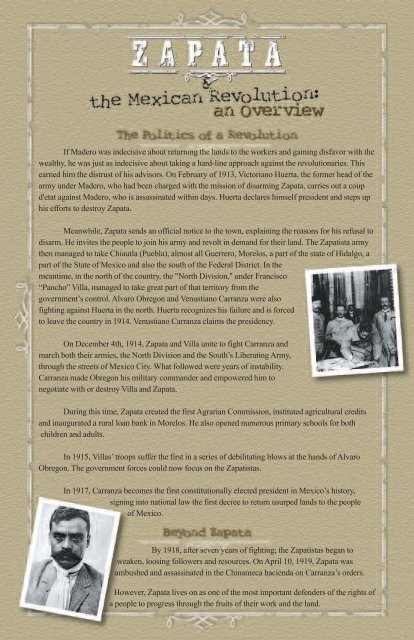Zapata Project 1
Zapata Project 1
Zapata Project 1
You also want an ePaper? Increase the reach of your titles
YUMPU automatically turns print PDFs into web optimized ePapers that Google loves.
If Madero was indecisive about returning the lands to the workers and gaining disfavor with the<br />
wealthy, he was just as indecisive about taking a hard-line approach against the revolutionaries. This<br />
earned him the distrust of his advisors. On February of 1913, Victoriano Huerta, the former head of the<br />
army under Madero, who had been charged with the mission of disarming <strong>Zapata</strong>, carries out a coup<br />
d'etat against Madero, who is assassinated within days. Huerta declares himself president and steps up<br />
his efforts to destroy <strong>Zapata</strong>.<br />
Meanwhile, <strong>Zapata</strong> sends an official notice to the town, explaining the reasons for his refusal to<br />
disarm. He invites the people to join his army and revolt in demand for their land. The Zapatista army<br />
then managed to take Chiautla (Puebla), almost all Guerrero, Morelos, a part of the state of Hidalgo, a<br />
part of the State of Mexico and also the south of the Federal District. In the<br />
meantime, in the north of the country, the "North Division," under Francisco<br />
“Pancho” Villa, managed to take great part of that territory from the<br />
government’s control. Alvaro Obregon and Venustiano Carranza were also<br />
fighting against Huerta in the north. Huerta recognizes his failure and is forced<br />
to leave the country in 1914. Venustiano Carranza claims the presidency.<br />
On December 4th, 1914, <strong>Zapata</strong> and Villa unite to fight Carranza and<br />
march both their armies, the North Division and the South’s Liberating Army,<br />
through the streets of Mexico City. What followed were years of instability.<br />
Carranza made Obregon his military commander and empowered him to<br />
negotiate with or destroy Villa and <strong>Zapata</strong>.<br />
During this time, <strong>Zapata</strong> created the first Agrarian Commission, instituted agricultural credits<br />
and inaugurated a rural loan bank in Morelos. He also opened numerous primary schools for both<br />
children and adults.<br />
In 1915, Villas’ troops suffer the first in a series of debilitating blows at the hands of Alvaro<br />
Obregon. The government forces could now focus on the Zapatistas.<br />
In 1917, Carranza becomes the first constitutionally elected president in Mexico’s history,<br />
signing into national law the first decree to return usurped lands to the people<br />
of Mexico.<br />
By 1918, after seven years of fighting; the Zapatistas began to<br />
weaken, loosing followers and resources. On April 10, 1919, <strong>Zapata</strong> was<br />
ambushed and assassinated in the Chinameca hacienda on Carranza’s orders.<br />
However, <strong>Zapata</strong> lives on as one of the most important defenders of the rights of<br />
a people to progress through the fruits of their work and the land.







